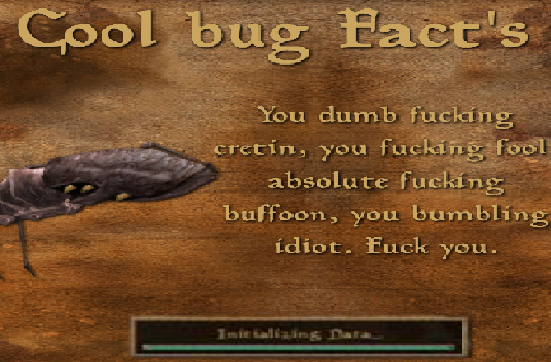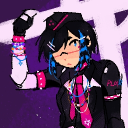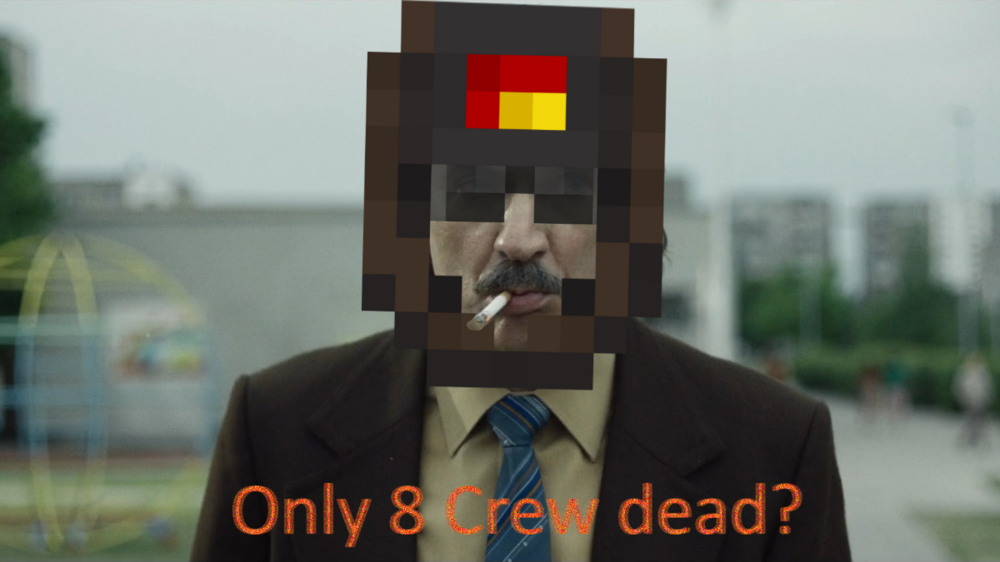-
Posts
2,979 -
Joined
Content Type
Profiles
Forums
Events
Gallery
Everything posted by Scheveningen
-
This basically reminds me of the old Aurora service sector where it was in the center of the donutstation. It was awesome, and it was the saddest thing ever to have to see it go when we made the rebase to Bay. Nostalgia aside, it was objectively the best service sector design. It was great, all of the chill-out zone was dedicated in a specific fun little place. While this isn't quite the same as that, it's very close -- and I'm happy to see the actual main bar itself isn't connected to the fore hallway. That always just gave me a headache.
-
Looks fine there.
-
The entire service area being an open-air area is a nightmare for a spaceship, and for engineering to pressurize this spot. A singular decompression event risks killing a lot of people extremely quickly, as explosive decompression is no joke. This shouldn't be as open-air as atmospherics, which at least has a reason for an area of more than 50 tiles. A fifth chair in the corner of the back section of the bar doesn't make a lot of sense because anyone seated is not aligned in front of the counter. I'm sad to see the Pun Pun enclosure with a sleepytime bed was heavily nerfed. I insist this be restored.
-
Add the mime role
-

Make the Executive Officer the ship's second in command.
Scheveningen replied to Kintsugi's topic in Suggestions & Ideas
Cutting the OM out or just demoting them down kind of recreates the issues we already had with the quartermaster role, in that it had no authority and was functionally useless. Since we effectively have +1 head of staff over what we used to, and the XO's technical skills involving with piloting the ship equivalent to the captain, in addition to using the other weapon/utility systems, there is genuinely no reason why not to empower the XO to be second to the captain. That's the definition of what an Executive Officer to a naval ship is - and this is regardless if the ship is military or not. Most people regard it as being not, but having a more clearly defined chain of command and 2 persons with absolute authority who can easily push command out of decision gridlock is essential. The role of the XO would be fairly simple, however. The captain is chiefly responsible for delegating their orders. It is the responsibility of the XO, and other members of command, to execute those orders. However, the XO can simply intrude into another lane and ensure the respective head of staff is getting the requested job done, so that the captain does not have to show up and ensure that is what is being carried out. This frees the captain up to have physical presence elsewhere, organize what they need to and otherwise spend their attention on equally/moreso pressing issues. On a secondary note, may as well just make the OM the O&SM (or OSM, if it sounds better). It would not be too much to extend the OM's authority a little more, and cut some of the unnecessary chaffe from the XO's purview. Operations and service are not difficult departments to manage - as one side is distribution and the other is essentially retail, and I believe service would GREATLY enjoy the interconnectivity that would be established with operations, being able to ask their head of staff directly for anything instead of having to go through a sophisticated chain of command just to get through to operations. -
Ethnic, cultural, and religious differences have been used by the nobility to stop the Tajara people from uniting against the oppression. These barriers have finally been broken during the Revolution. As history shows them, the establishment of a united Adhomai under a Hadiist state is necessary to secure the future of the Tajara. They must abandon their past sectarianism and work as one. Hadiism will shape all aspects of their lives for the better. The Tajara will be powerful and free as long they are guided by the Party. Together the Tajara are undefeatable.
-

Aurora's Division of Armor problem, and a proposal to fix it
Scheveningen replied to Scheveningen's topic in Archive
Stays the same. They're extremely powerful packages-at-a-cost as-is, the hazard sec suit being on the lighter side but lets you have pretty wacky offensive and utility packages. The SCC combat suit is much of the same in terms of offering powerful weaponry and utility, but it is up-armored - and a bit slower, to my recollection? No need to change stuff there, their effective armor values make sense for the resource cost they require. Miners have to be doing their jobs -- which is not an overly stimulating job even with the PvE out there -- and research has to be updating the levels for machining to be doing their work. Ballistics and ablatives in my mind just need to go. Or get reworked into being ablative/ballistic shields as an alternative to riot shields. Lets people use that utility defense while forsaking a two-handed weapon. -
This is specifically with regard to plate carrier modular armor. Presently, there are a few categories of suits of modular armor that exist within the game, each with their specific roles and statistics. These are: The security officer's vest/generic armor vest set, also found in the crew armory. This is equivalent to a measly tier 3 to tier 4 all-around weapon protection, but is certainly better than nothing. This might block something that does less than 20 damage, but not much more than that. The heavy corporate suit, or the tan heavy armor set. This is equivalent to tier 5-6 protection, and will block small damage attempts, or soften small caliber bullets without issue, but generally cannot compete to rifle caliber weaponry or better. The slowdown is considerable when wearing this armor. This is effectively the "medium armor" tier of available armor. The next category is odd, as they all include the riot suit, the ballistic suit, and the ablative suit. These are all one-trick pony suits that almost completely block incoming damage -- of a specific damage type that they correspond to, roughly tier 7. Riot for melee, ballistic for bullets, ablative for energy and laser projectiles. For damage that they are not specialized for, they do "fuck all" in terms of protection, with a measly tier 1 protection modifier. Interestingly, they have the exact same slowdown as the medium armor already mentioned. This category isn't even necessarily heavy armor -- it's situational heavy armor. If you have ablative armor, you can't peek the hallway that has a 7.62 rifle pointing down it, or you will get clipped and are expected to be mandatorily sent to medbay. --- To me, this division of armor to be specialized rather than generalized is deeply unsatisfying, and does not really make much sense to even mass-produce to be available. Antagonists have no equivalent access that which security possesses to specialized heavy armor. And frankly, the ballistic suits tend to be far more useful anyway, as taking bullets are the most dangerous, due to how easy guns are to shoot, but lasers don't inflict the great risk of internal bleeding, bone breaks or organ damage on the first blow. And even if antags did have their own version of ballistic armor, well, laser rifles exist, regardless of the side, leading to a stupid "rock paper scissors" game loop rather than simply abiding to what is simpler and more satisfying game logic: if you get shot too much, you should probably die. We can extrapolate reasonable responses to this: Either do not be in a position to get shot up too much, or bring heavier armor to soften the blows you take in order to get what you want accomplished. Or have something in-between, why not? Medium armor would still be usable for whoever is left over in the department, or for merc teams. We can do some neat meaningful tradeoffs for armoring up versus armoring down, too. I'll provide a proposal for what I think would actually be better. -- Stab vest: becomes part of the roundstart basic officer, warden, cadet, and investigator kit, replacing the "light" set of armor for the security department. While they possess identical armor values to the light kevlar set, armguards and leg-guards cannot be attached, and no helmet is included. This is just a basic code green kit - and since the old light vest was not mandatory to wear before, this does not have to be either. No slowdown, 3 slots for tools or other small items. Light kevlar plate carrier (formerly the security officer's plate carrier, identical to generic plate carrier also found in the crew armory): Moved to the basic brig armory with 4 carriers, helmets and arm/legguards, resistances stay as generalized as they already are. Has expanded-capacity drop pouches exclusive to light plates, allowing 5 slots for tools. The light kevlar helmet has an integrated GPS and helmet camera to be enabled at will, in addition to an integrated flashlight. It has two slots, perhaps for weapon magazines, or for your debilitating smoking habit. The crew armory generic armor set also share these upgrades, to permit the militia decent utility in a red alert crisis. 0.3 slowdown. The head of security's locker starts with a variant of the light kevlar armor plating, with an easy to pick out helmet and same old special stripes. The warden does as well, albeit as fancy as a standard light kevlar plate carrier. Medium ceramic plate carrier (formerly the heavy [corporate] plate carrier set): 3 vests included in the brig armory. Resistances decreased effectively to tier 4-5. Drop pouches contain 3 slots for anything small, and are exclusive to medium plates. The medium ceramic helmet has one slot for a weapon magazine -- or maybe for a pack of Space Newports? -- and an integrated flashlight/GPS. Slowdown decreased to 0.6 from the old heavy corporate armor. Heavy riot plate carrier: The actual heavy armor suit. Only one is included, ideally for the person expected to take the majority of the punishment for the security team. Effectively tier 6-7 general protection, with an encumbering 1.25 slowdown. Drop pouches may only contain 2 small items, and the heavy riot helmet offers no space for a magazine, given the real estate of the helmet is entirely dedicated to reinforcement and a punishment-immune reinforced glass flip-visor. The helmet still contains a GPS and an integrated flashlight. Riot shields are included with the medium and heavy armor sets, for a total of 4 riot shields. Notice there's still space free in the armory for another suit set? No need for it. Maybe replace the empty space with a sleepy armory owl on a perch that noisily hoots at people that walk in, or something? -- Okay, so, why all this for security? Put simply: people get to have roles now! The head of security, investigators, warden, and cadet generally aren't encouraged to go see combat, and instead provide, during a code red situation, uses for resolving the crisis that don't involve headbutting directly into the threat. They need to stay light on their feet, and most especially should be trying to transmit important information to their major frontliners. Their helmet utilities also provide the most immediate uses for anyone sitting on cameras, they can keep track of who's scouting around and also provide for second-hand accountability if someone does something they shouldn't and there are two witnesses for it. As for the officers, you have effectively three linebackers and one quarterback (pardon the sportsball references). The officers in medium armor have reasonable enough protection to hold any flanks, or the backline, or otherwise go at the adversary from the side like a hammer, while the person in heavy armor is the slowly moving anvil. If the officers don't work as a team, their quarterback will get quickly isolated and iced by a mercenary team that means business. Of course, most of this is best case scenario. Sometimes the HOS (due to a small manifest) is the only person who can take the pressure of frontrunning a serious threat and take most of the pressure. And so on and so forth. Speaking of mercenaries, they should also be limited and beheld to similar lines of logic, with some smaller wrinkles. They get two heavy suits in their armory, two medium suits, and two light suits - as merc teams can only go up to 6. Merc teams have to figure out how to distribute that armor just as much as security does, but they get to have two slow armor tanks instead of the one security has to manage. -- I think the proposal, if implemented, will make shooting each other a bit less stale than it has been currently, as well as make gunfights much more predictable and meaningfully engaging to plan for. In an ideal situation, you could just walk away from the guy in the heavy armor and avoid a confrontation, but you have to deal with the quicker ones, or they'll never give you a break.
-

Cold Dawn - Fourth Episode: To the End of the World
Scheveningen reviewed Alberyk's event in Event Calendar
wack-
- 1
-

-
Nostalgia is a funny little mind trap. As Skull said it wasn't like there was any more of a direction towards anything compared to today, which it can't be said it's really that fundamentally different today -- aside from the amazing development progress made since then. I unfortunately deleted some of my more ancient screenshots of that time period, but suffice to say the game looked much uglier back then. Aurora's point was and is just to have a space for roleplay without the griefing bullshit other servers often tolerate. We don't need to enshrine the people that made this possible to such an extreme extent - since most of them aren't here anymore, have moved on, etc. They're just checking in and saying hi, wow, this place has changed! And that's cool and all. We don't really need to go much further there. I'm sure "immortalizing" whatever prior aspect to Aurora does not actually matter to you guys. It'd be a waste of effort, frankly, effort that could be better spent coming up with new ideas on how to keep Aurora going into the future rather than kept in the past.
-
The machinist should only be in charge of prosthetic limb maintenance/replacement, but should not be anywhere near a person's organs, because organ replacement intrudes into surgeon's territory as you need to open someone's body up to do that. They fetch whatever is needed for medical otherwise. They can make mechs, hardsuits, robots, etc. Their job isn't as dull as it seems.
-

LF one hard knock bodyguard
Scheveningen replied to Sheeplets's topic in Syndicate Transmission Network
sir this is a Clucker Bell -

WTB one real nasty son of a bitch
Scheveningen replied to Kintsugi's topic in Syndicate Transmission Network
where and when -
Characters got PK'd in the last event because no one, and I am not exaggerating with this, made an actual avid attempt to organize groups of people to stick together and stay safe. They got split up, they wandered aimlessly around without a plan, and did not respect the danger that the local wildlife and the hazard that the nearby minefield represented. They did not respect the advisement by their local medical professionals to play it safe and not risk getting injured because the medical facilities were extremely bad and barebones. It really was just an issue of skill. Characters should always be putting their own self-interest of safety first, or else they will pay that consequence of no longer being safe. Play stupid games, win stupid prizes. With the change of the next event from medium intensity to high intensity, I am sure people will realize not to fuck around if they do not wish to find out this time.
-
I genuinely cannot believe this is the hill that was dictated to be worth dying on. An important lesson I learned from Posting Through It a fair deal of time ago is that if you write a Substack worth of grievances expecting it to be read by anyone that actually matters, expect to be disappointed because human beings are easily exhausted by very long posts. A person who generally cares less would see any of the 2000-word length hitpieces posted recently and respond with something like, "Good grief, I should log off for awhile and so should everyone else involved in this." And that would probably be mentally healthier and satisfying for that person explicitly. Instead I'm going to express some advice against my better judgement. - Posting Through It without the aid of a communications professional is always a bad idea. - Things that are different are not the same. They do not bear any reason to be compared to each other. - Being ironically or unironically hyperbolic generally does not amuse most people, and will generally lead them to not take a cited issue seriously if it is addressed and represented poorly. - Sticking up for other people publicly has to be done cautiously and correctly, because most people associate this with also sticking up for another person's decisions, which isn't far off from being associated with endorsing the decisions another person made. - Equating staff actions in making someone unable to play the game until they successfully conjure up a believable reason to be unbanned with "[inflicting] suffering" is definitely an interesting tactic. I would like to point out that a really terrible humanitarian crisis in Yemen is presently ongoing, such as in one case where a child between 2-4 weeks old was inducted with their mother into emergency medical care for malnutrition and a dangerously high fever. They were not able to be moved to a different facility inside the hospital by the understaffed and underequipped workers inside to try different healthcare methods because doing so would risk them dying in transit. The day of that a media reporter released this coverage regarding this story about this Yemeni mother and child, they reported that the hospital's efforts to continue stabilizing the child would end up failing. I suggest having an actually meaningful metric for what "suffering" actually is, because I think being banned from a video game community doesn't quite hit even the fucking bar of how shitty life can get for someone.
-
Forum reacts should be removed, period. Leaving only the "positive ones" will simply lead to later complaints down the line of forum post ratioing, which will summon the same discourse about forum toxicity. I wouldn't hold the view that this was a failed experiment, we all knew how this was going to go. It's so over.
-
Wait, Girdio is fucking voltage? I never knew.
-
considering the literal horror that has been the last 2 weeks reading these forums it is an incredibly pleasant surprise to see you posting again. This is a quadruple dose of nostalgia, though. Can't believe it's been almost 10 years. I'm so sorry for your father, I had no idea that's why you haven't been around for so long. The good news is the server is still around, and still maintains its HRP label. Everything's gotten more complicated since 2012-ish SS13 era, though. Hope you enjoy your time here.
-







